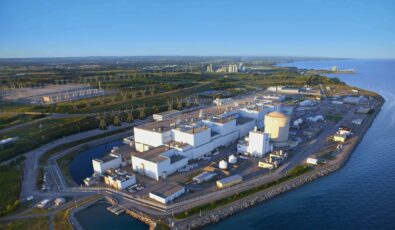OPG’s Laurentis Energy Partners cleared to produce even more life-saving isotopes at Darlington Nuclear station
At a glance
- The Canadian Nuclear Safety Commission has approved a licence amendment that allows OPG’s subsidiary Laurentis Energy Partners to begin producing life-saving isotopes lutetium-177 and yttrium-90 at the Darlington Nuclear station.
- The isotopes are used in targeted radionuclide therapy to treat various cancers and tumours.
- Laurentis will use its Target Delivery System to produce the critical isotopes at Darlington.
An Ontario-made nuclear innovation is continuing to save lives—here and around the world.

On May 26, the Canadian Nuclear Safety Commission (CNSC) announced its decision to amend OPG’s power reactor operating licence for the Darlington Nuclear Generating Station to authorize production of lutetium-177 (Lu-177) and yttrium-90 (Y-90).
The two isotopes are critical in life-saving nuclear medicine. Lu-177 is used in targeted radionuclide therapy for treating rare tumours and prostate cancer. It is currently the most commonly used isotope for targeted radionuclide therapy. Meanwhile, Y-90 is used to treat several diseases, primarily advanced liver cancer and other large inoperable tumours.
The amended licence clears the way for OPG subsidiary Laurentis Energy Partners to use its proprietary Target Delivery System, developed in partnership with BWXT Medical Ltd. and installed on Darlington’s Unit 2, to produce the important isotopes.
Darlington Nuclear Generating Station is not only helping power Ontario’s growing clean energy needs; it is also powering the future of cancer care. The isotopes produced at Darlington will have real-world impact for cancer patients around the world.Nicolle ButcherPresident and CEO, OPG
It’s a development that further cements Ontario’s role as a world leader in the production of critical medical isotopes.
Laurentis’s Target Delivery System harvests isotopes in one-third of the time compared to competing systems. The innovative technology is already being used at Darlington to produce Molybdenum-99 (Mo-99), an isotope critical to about 85% of nuclear diagnostic scans worldwide. |
The go-ahead for production of Lu-177 and Y-90 is just the latest in isotopes innovation for OPG and Laurentis—a journey that began more than 50 years ago at OPG’s Pickering Nuclear station.
At Pickering and now at Darlington, OPG produces Cobalt-60, which is used to sterilize 30% of all single-use medical devices. OPG also repurposes tritium for use in safety signs, pharmaceuticals, and future nuclear fusion technology.
Meanwhile, in addition to Mo-99, Y-90, and Lu-177, Laurentis is advancing production of Helium-3, a rare isotope that supports MRI technology, quantum computing, nuclear research, and border security.
As the demand for medical and industrial isotopes grows, OPG and Laurentis will continue to explore new ways to turn nuclear innovation into global impact.
Subscribe and stay informed
Sign up to receive the latest news, project updates, and event information from OPG.


